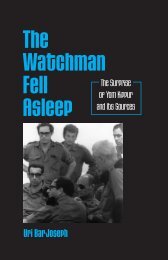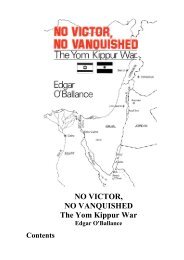israeli fortifications of the october war 1973
israeli fortifications of the october war 1973
israeli fortifications of the october war 1973
Create successful ePaper yourself
Turn your PDF publications into a flip-book with our unique Google optimized e-Paper software.
The weapon <strong>of</strong> choice for <strong>the</strong><br />
defence <strong>of</strong> <strong>the</strong> Maozim and<br />
Taozim against ground attack<br />
was <strong>the</strong> .sO-cal. Browning<br />
M2HB on account <strong>of</strong> its<br />
reliability in <strong>the</strong> harsh<br />
conditions <strong>of</strong> <strong>the</strong> Canal Zone<br />
and its anti-material capability<br />
against assault boats,<br />
amphibious AFVs et al. This<br />
twin .sO-cal. with gunshield<br />
is a former naval mounting<br />
salvaged from Israeli naval<br />
destroyers as <strong>the</strong>y were<br />
phased out <strong>of</strong> service. Note <strong>the</strong><br />
prefabricated machine-gun pits<br />
in <strong>the</strong> background that gave<br />
protection to <strong>the</strong> crew and<br />
provided ready ammunition for<br />
<strong>the</strong> weapon. This gun pit still<br />
exists at Taoz Tzeider with <strong>the</strong><br />
Gulf <strong>of</strong> Suez on <strong>the</strong> horizon.<br />
(Stuart Bracken)<br />
OPPOSITE<br />
As <strong>the</strong> War <strong>of</strong> Attrition<br />
progressed, <strong>the</strong> Egyptian<br />
air defence system became<br />
increasingly extensive and<br />
sophisticated as new<br />
equipments were introduced<br />
such as <strong>the</strong> 5-125 Pechora (SA-3<br />
Goa). These were supplied from<br />
January 1970 with Operation<br />
Kavkaz (Caucasus) when<br />
Soviettroops <strong>of</strong><strong>the</strong> '11th<br />
Dnepropetrovsk' were assigned<br />
to man <strong>the</strong> 5-125 batteries.<br />
This is <strong>the</strong> combination <strong>of</strong> <strong>the</strong><br />
5-125 Pechora and <strong>the</strong> SNR-125<br />
(Low Blow) fire-control radar<br />
that provided low to medium<br />
altitude air defence to<br />
complement <strong>the</strong> high altitude<br />
coverage <strong>of</strong> <strong>the</strong> SA-75 Dvina.<br />
During <strong>the</strong> War <strong>of</strong> Attrition,<br />
<strong>the</strong> SAM batteries undertook<br />
124 engagements firing 266<br />
missiles and claiming 32 Israeli<br />
aircraft destroyed while <strong>the</strong><br />
IAF admitted to <strong>the</strong> loss <strong>of</strong><br />
13 aircraft to both SAMs and<br />
AAA during <strong>the</strong> same period.<br />
(Lon Nordeen)<br />
34<br />
address <strong>war</strong>ning <strong>of</strong> <strong>the</strong> dangers <strong>of</strong> <strong>the</strong> 'Sovietization <strong>of</strong> <strong>the</strong> conflict'. On 13<br />
April 1970, Israel suspended its deep penetration raids into Egypt for fear <strong>of</strong><br />
provoking <strong>the</strong> Soviet Union fur<strong>the</strong>r, although a botched bombing raid that<br />
killed 47 Egyptian children and wounded 30 o<strong>the</strong>rs in an elementary school<br />
in <strong>the</strong> village <strong>of</strong> Bahr EI-Bakr was a contributory factor.<br />
The aerial campaign had failed in its aims. It had not ended <strong>the</strong><br />
unremitting War <strong>of</strong> Attrition along <strong>the</strong> Suez Canal where Israeli casualties<br />
were still averaging 12 deaths a month. Between October 1969 and March<br />
1970, <strong>the</strong> IDF suffered 59 killed and 159 wounded on <strong>the</strong> Sinai Desert/Suez<br />
Canal front. In <strong>the</strong> same time frame, <strong>the</strong>re were 2,427 incidents along <strong>the</strong><br />
Bar Lev Line, comprising 1,124 with small arms, including snipers, 577 with<br />
mortars, 641 with artillery as well as 95 o<strong>the</strong>rs including air and ground<br />
attacks. From March on<strong>war</strong>ds, <strong>the</strong> number <strong>of</strong> incidents increased, as did <strong>the</strong><br />
severity <strong>of</strong> <strong>the</strong> artillery bombardments, resulting in yet more Israeli casualties.<br />
More worrying was <strong>the</strong> direct intervention <strong>of</strong> Soviet troops into <strong>the</strong> conflict,<br />
which greatly complicated Israel's political and military position. The risks <strong>of</strong><br />
<strong>the</strong> conflict escalating fur<strong>the</strong>r were now too dangerous for all parties. At<br />
midday on 8 August 1970, a ceasefire sponsored by <strong>the</strong> United States and<br />
supported by <strong>the</strong> Soviet Union was agreed and <strong>the</strong> fighting spluttered to an<br />
end. IDF Captain David Halevy recalled: 'The quiet along <strong>the</strong> canal was<br />
deafening for anyone who had been <strong>the</strong>re when <strong>the</strong> artillery was in full blast.<br />
Some <strong>of</strong> <strong>the</strong> men played chess; o<strong>the</strong>rs were in <strong>the</strong> open cleaning rifles or<br />
writing letters. In one fott <strong>the</strong>y opened two bottles <strong>of</strong> wine supplied< by <strong>the</strong><br />
chaplain and drank a I'chayim [to life].'<br />
The agreement stipulated that <strong>the</strong>re was to be no military activity in a<br />
50km-wide zone on each bank <strong>of</strong> <strong>the</strong> Suez Canal. Within days <strong>the</strong> Egyptians<br />
began to move missile batteries closer to <strong>the</strong> Suez Canal. The Israelis<br />
protested and some advocated a resumption <strong>of</strong> hostilities but <strong>the</strong> Mirage,<br />
Skyhawk and Phantom pilots that had borne <strong>the</strong> brunt <strong>of</strong> <strong>the</strong> air campaign<br />
were exhausted. Moreover <strong>the</strong> Israeli people drew a collective sigh <strong>of</strong> relief<br />
at <strong>the</strong> prospect <strong>of</strong> peace. Between March 1970 and <strong>the</strong> ceasefire, Israeli<br />
casualties on <strong>the</strong> Egyptian front amounted to 92 killed and 249 wounded<br />
with <strong>the</strong> death toll rising to almost 20 a month. The black-bordered<br />
photographs <strong>of</strong> <strong>the</strong> fallen appearing in <strong>the</strong> newspapers seemingly every day<br />
were a constant reminder <strong>of</strong> <strong>the</strong> price being paid by <strong>the</strong> IDE The <strong>war</strong> had cost<br />
over 500 dead and 2,000 wounded on all fronts, more than twice <strong>the</strong> number<br />
suffered in <strong>the</strong> 1956 Sinai campaign. From 15 June 1967 to 8 August 1970,<br />
367 Israeli soldiers were killed on <strong>the</strong> Egyptian front with 260 <strong>of</strong> <strong>the</strong>m<br />
between March 1969 and August 1970.<br />
In <strong>the</strong> last five months <strong>of</strong> <strong>the</strong> <strong>war</strong>, <strong>the</strong> incidence <strong>of</strong> artillery barrages<br />
against <strong>the</strong> Bar Lev Line rose from 50 to 85 per cent <strong>of</strong> all incidences by fire<br />
that caused considerable damage to <strong>the</strong> <strong>fortifications</strong>.<br />
Despite <strong>the</strong> conditions <strong>of</strong> <strong>the</strong> ceasefire, <strong>the</strong> Israelis began immediate<br />
repairs to <strong>the</strong> line. The Egyptians claimed it was this violation <strong>of</strong> <strong>the</strong> ceasefire<br />
agreement that prompted <strong>the</strong>m to move for<strong>war</strong>d <strong>the</strong>ir SAM batteries. Israeli<br />
aircraft losses in <strong>the</strong> final weeks <strong>of</strong> <strong>the</strong> <strong>war</strong> were becoming unacceptable<br />
against <strong>the</strong> enhanced missile screen that now extended its reach over <strong>the</strong> Suez<br />
Canal. But <strong>the</strong> lesson was soon forgotten and <strong>the</strong> belief arose that it was <strong>the</strong><br />
IAF that had protected <strong>the</strong> Bar Lev Line and forced a ceasefire on <strong>the</strong><br />
Egyptians. Similarly, a belief grew that <strong>the</strong> Maozim had more than proved<br />
<strong>the</strong>ir worth and could hold out against any Egyptian incursion, despite <strong>the</strong><br />
fact that <strong>the</strong>ir artillery had been pulverizing <strong>the</strong> positions to <strong>the</strong> end. The<br />
Israeli political establishment believed that <strong>the</strong> <strong>war</strong> had been won since <strong>the</strong><br />
status quo had been preserved in <strong>the</strong> Sinai Peninsula and this belief was<br />
Taoz Tzeider was at <strong>the</strong><br />
sou<strong>the</strong>rn end <strong>of</strong> <strong>the</strong> Bar Lev<br />
Line comprising massive<br />
fortified emplacements<br />
encasing six French Obusier de<br />
155mm Modele 50 howitzers<br />
that dominated Suez City and<br />
<strong>the</strong> sou<strong>the</strong>rn entrance <strong>of</strong> <strong>the</strong><br />
Suez Canal. Today <strong>the</strong> position<br />
is largely intact and forms part<br />
<strong>of</strong> a museum. (Stuart Bracken)<br />
35




